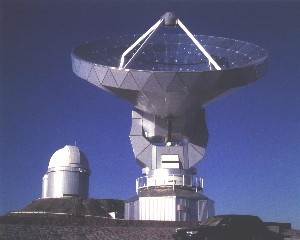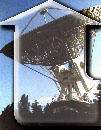Metsähovi Radio Observatory
AGN Research with the Swedish-ESO Submillimeter Telescope (SEST)
 The Swedish-ESO
Submillimetre Telescope, SEST,
is a 15m diameter radio telescope situated at the European Southern Observatory site
on Cerro La Silla, at 70.73 deg. W, 29.26 deg. South, 2300 m. The
ideal location in the Chilean Andes, together with the high
surface accuracy (70 microns rms) and sophisticated receiver
equipment makes SEST an optimal telescope for high frequency (90
to 230 GHz) monitoring of southern active galactic nuclei. Flux
density measurements of extragalactic radio sources have been
made with the SEST telescope by our team from the very beginning
of the SEST operation (since 1988). The SEST AGN flux monitoring
project is closely connected to our group´s long-term flux
density monitoring done at Metsähovi at lower (22 to 37 GHz)
radio frequencies (Metsähovi quasar
research project) The SEST monitoring project, however, is
unique in providing us with large sets of high frequency data and
information on otherwise rarely observed southern hemisphere
sources.
The Swedish-ESO
Submillimetre Telescope, SEST,
is a 15m diameter radio telescope situated at the European Southern Observatory site
on Cerro La Silla, at 70.73 deg. W, 29.26 deg. South, 2300 m. The
ideal location in the Chilean Andes, together with the high
surface accuracy (70 microns rms) and sophisticated receiver
equipment makes SEST an optimal telescope for high frequency (90
to 230 GHz) monitoring of southern active galactic nuclei. Flux
density measurements of extragalactic radio sources have been
made with the SEST telescope by our team from the very beginning
of the SEST operation (since 1988). The SEST AGN flux monitoring
project is closely connected to our group´s long-term flux
density monitoring done at Metsähovi at lower (22 to 37 GHz)
radio frequencies (Metsähovi quasar
research project) The SEST monitoring project, however, is
unique in providing us with large sets of high frequency data and
information on otherwise rarely observed southern hemisphere
sources.
Main objectives of the high radio frequency monitoring of AGN
 |
AGN monitoring since 1989, Metsähovi-Turku -collaboration |
 |
Higher radio frequencies: 90 GHz & 230 GHz
|
 |
New information about the rarely observed Southern sources |
 |
Information about the high-frequency behaviour of the sources |
 |
Complete flux curves for the equatorial
sources |
 |
General source properties: spectra, variability |
 |
Correlating outbursts at various frequency domains (radio-optical-gamma): dense monitoring/long term monitoring |
 |
Testing and developing of shock models for outbursts |
 |
Source classification, unification |
 |
Predicting and interpreting VLBI behaviour |
Some of our recent SEST continuum monitoring projects
Multifrequency observations of EGRET -detected gamma ray blazars
This project was initiated at the beginning of the CGRO operation. These observations are very important because for a short time still we will have the valuable opportunity to observe these sources across the electromagnetic spectrum from gamma to the radio frequencies. The project has several goals:
- To monitor good candidates for our group's CGRO Target-of-opportunity observing proposal at the high radio frequencies.
- To get detailed multifrequency spectrum of a flaring source in order to further study the emission mechanisms of gamma-rays and the relationsships of the various observing frequencies during a flare.
- To make follow-up observations at the SEST frequencies of
EGRET- detected southern AGN. Most of these sources have not
been extensively observed at mm-frequencies, and more detailed
studies of the spectra and variability are necessary for more
thorough understanding of the nature of various sources.
Long term monitoring of active galactic nuclei
This was an on-going project initiated in the very beginning of the SEST operation, but now officially discontinued. The objective was to frequently monitor a relatively small sample of bright and variable sources in order to get well-sampled, high frequency time series for the selected sources, as well as to get good multifrequency coverage for some of the most interesting nearly equatorial AGN. We still occasionally get the chance to monitor some of the most interesting sources from this source list at the SEST observing frequencies.High radio frequency ground support for VSOP observations of AGN
The VSOP space-VLBI satellite was succesfully launched in February 1997. Metsahovi researchers are involved in a very large number of VSOP observing proposals, and most of these projects use also SEST data for ground support.The VSOP satellite is a new powerful tool for studying the structure and physics of AGN. Ground-based radio observations will be essential for most of these projects, because:
- The monitoring data can be used to relate the observed VLBI features to the events observed in the flux curves during the monitoring, and thus help in understanding the shock formation and the structural changes in the shock component. SEST is one of the few telescopes capable of observing the southern VSOP sources, and its high frequency flux curves are valuable also for the more northern sources.
- Radio monitoring data can be used to determine wether a source is in its flaring or quiescent state, or to select soruces with currently observable interesting events (especially Targets-of-opportunity)
- Flux density information gathered with ground based telescopes is important in constructing spectra for the observed sources.
- Long time series of monitoring data (as we already have for some of our sources observed with the SEST) can be used to determine the variability evolution of the sources.
- High-frequency radio observations can be used to predict outbursts at lower frequencies, because the outbursts often are time delayed.
SEST publications
SEST-data from 1989 to June 1994 were published in: Tornikoski et al., Astronomy and Astrophysics Supplement Series 116, 157, 1996 and are available in electronic format at the CDS via anonymous ftp 130.79.128.5
For other data requests contact Dr. Merja Tornikoski.
 tkk.fi
tkk.fi

|
webmaster@kurp.hut.fi
Last modified: Monday, 24-Oct-2011 10:49:46 EEST |
| Back to Metsähovi home page |